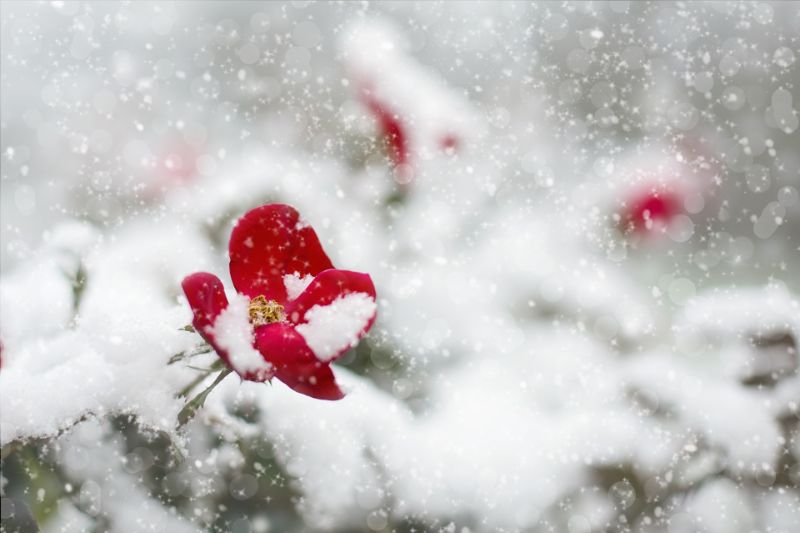If you’re wondering how cold is too cold for flowers to be outside, read on. On this page, you’ll learn what temperature range most flowers can tolerate and survive, and we’ll also give you some tips on how to keep your flowers alive.
What Temperature Do Flowers Freeze
Most flowers will freeze when the temperature drops below 28° Fahrenheit (-2° Celsius) for more than five hours. However, some flowers are more cold-hardy than others. Tender annuals will start to experience frost damage when temperatures hit 32°F (0°C). But cold-hardy flowers can tolerate temperatures down to 18° Fahrenheit (-7.7° Celsius).
How To Protect Flowers from Frost and Snow
The last thing you want to happen to your beautiful flowers is for them to be killed by frost or snow. But it’s not always possible to bring your plants inside and protect them from freezing conditions. Luckily, there are a few things you can do to keep your flowers alive during the colder months that we’ll go over below.
Frost Covers
Frost Covers (Buy Online) are a great way to protect your flowers from frost and snow. They’re easy to install and provide excellent protection from cold snaps in the spring, winter, and fall. To learn more about how you can use frost covers to keep your garden blooming when it gets cold, click here ( Best Plant Covers for Cold Weather)
Cold Frame Greenhouse
A Cold Frame Greenhouse (Buy Online) is a great way to extend your growing season at a low cost. . And cold frame greenhouses will protect your flowers beds from wind, frost, and snow.
Mini Greenhouse
A Mini Walk-in Greenhouse (Buy Online) will protect your plants from frost and snow without taking up too much space or costing an arm and a leg. Its zippered entrance at the front makes it easy to access all of your plants, while its 2 roll-up side windows will keep your flowers from overheating in the midday sun. It’s also portable so you can easily fold it down and store or take it with you wherever you go.
Thermal Storage
Water Filled Plant Insulators (Buy Online) will help prevent frost from damaging your plants by the keeping air around them warm even when temperatures drop below freezing. This set includes everything needed to start gardening as early as possible in the season including a step-by-step guide on how to use these protective devices correctly.
Soil Heating Cable
Soil Heating Cables (Buy Online) are a powerful solution to protect any kind of vegetation against cold weather. They are easy to install, just stick it into the ground in the early spring or late fall. And with 48 feet of cable that lasts for many seasons this heating cable is great for large flower beds and decorative borders.
Black Plastic Mulch
Black Plastic Mulch (Buy Online) helps insulate plants from cold temperatures, and it will also help thaw out frozen soil in the late winter and early spring.
How To Protect Perennials Over Winter
Straw Mulch
Pine Straw Mulch (Buy Online) is a great, natural way to protect perennials in your winter garden. Mulching with straw will help insulate the roots from cold air and freezing temperatures while also protecting against moisture loss when the ground freezes over.
Wood Mulch
Covering perennials with Wood Mulch (Buy Online) is a great way to protect them from winter weather, and it will also help block weeds as well as preserve soil moisture. There are also many other benefits to using wood mulch and it can be easily found at most local nurseries or home improvement stores.
What Temperature Will Kill Flowers
Will 18 Degrees Kill Flowers
Most annual flowers will die once temperatures reach around 18 degrees Fahrenheit, but there is a catch. If the temperature dips during the night to 18 degrees Fahrenheit for only a short period, then some extremely cold-hardy flowers might survive temperatures this cold.
Will 28 Degrees Kill Flowers
Most flowers will die at 28 degrees Fahrenheit, but some cold-hardy flowers will survive until they are finally killed off by a prolonged hard frost.
Will 30 Degrees Kill Flowers
Some cold-hardy flowers will survive 30-degree temperatures, but most tender annuals will not survive at this temperature even if it’s just for a few hours.
Will 31 Degrees Kill Flowers
While some flowers will survive 31-degree temperatures for a short time, this level of light frost will be deadly to most annual flowers.
Will 32 Degrees Kill Flowers
Some flowers will survive 32-degree temperatures but most will not. In general, flowering plants have a low tolerance for freezing conditions, and the water in their cells will become crystallized in these conditions.
Will 35 Degrees Kill Flowers
Most flowers will survive when exposed to 35-degree temperatures for a short time. However, tender annual flowers will need to be protected if they are to survive more than a few days at this temperature.
Will 36 Degrees Kill Flowers
Most flowers will survive temperatures near 36 degrees for a short time, but they will look a little worse for the wear. And annual flowers will take temperatures this low as a signal that the growing season is over.
Will 37 Degrees Kill Flowers
Flowers can survive at around 37 degrees but not for long. And at this temperature flowers will begin to quickly lose their vigor and disease resistance.
Will 38 Degrees Kill Flowers
Flowers can survive 38-degree temperatures for a short time. However, if the plant survives, it may become dehydrated and wilted, or shrivel up in a manner that is both unsightly and unrecognizable from its former glory.
Will 40 Degrees Kill Flowers
Most flowers can withstand 40 degrees temperature, but some might get damaged. However, some flowers like mums do well in cold weather, so they will still thrive when exposed to these temperatures.
Will 45 Degrees Kill Flowers
When temperatures reach 45 degrees it won’t harm most flowers but it will signal to them that colder weather is on its way, so they’ll need to begin preparing in order to adapt. This preparation includes shutting down their metabolic functions to wait out the colder days ahead, which causes them to produce less chlorophyll and break down non-essential compounds for energy.
How Cold Is Too Cold for Flowers Outside
The coldest temperature that you should keep most flowers in is 35 to 45 degrees Fahrenheit, but you can allow them to fall below 35 degrees for a few hours at night if the days are still fairly warm.
How Cold Can Flowers Survive
Most tender flowers will die when their cells freeze and most won’t survive below 32 degrees Fahrenheit. However, some cold-tolerant flowers have adapted to survive colder winters better than others.
How Cold Can Flowers Get at Night
Flowers will start to suffer when nighttime temperatures fall below 35 to 40 degrees Fahrenheit. Certain types of flowers like tulips and daffodils that typically grow in colder climates will be fine, but tropical plants like orchids and hibiscus should probably be put inside if temps drop below 45 degrees at night.
Read More: What Temperature is Too Cold for Hanging Baskets
Can Flowers Survive Frost
If you are a gardener in colder climates, then there is a good chance that you have experienced frost. Frost can be devastating to your garden and will kill any plant it touches. But don’t worry; flowers aren’t entirely defenseless against frost. Read on to find out more about how flowers survive cold weather.
Can Flowers Die from Frost
When it comes to the effect of cold temperatures on plants, some plants are quite sensitive and perish below 32°F, whereas others may be able to withstand colder temperatures for shorter periods before succumbing.
And some flowers, such as the paperwhite and snowdrop, will survive a hard frost since they produce natural antifreeze compounds.
With that said, we must remember that where we live has an important role in how we should treat our plants during the colder months. For example, a plant-lover living in Maine or Alaska might need to prepare for cold weather differently than one who lives at sea level in California or Florida.
Can Flowers Recover from Frost
Perennials and cold-hardy flowers will bounce back after a frost. Other flowers, including many annuals, may not be so lucky and will need to be replanted in the spring.
There are also some perennials available at nurseries that are considered “herbaceous” perennials – meaning they are referred to as perennial because they contain some evergreen features, but still need protection during severe winter weather conditions.
When Do Flowers Die in the Fall
The exact date varies according to where you live, but most flowers will start to die around November or October in the northern hemisphere.
Different plants have different lifespans and they will die back at different rates. But by the end of fall, many varieties of flowers will be wilting and show signs of decline as harsh weather rolls in.
And most flowers will start to suffer in mid to late fall and they will start to slowly die back once the temperature in your area reaches 45 degrees Fahrenheit.













